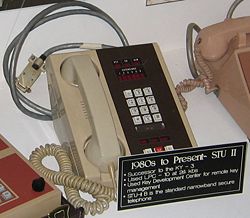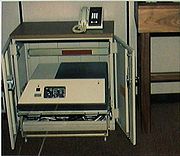
STU-II
Encyclopedia

Secure voice
Secure voice is a term in cryptography for the encryption of voice communication over a range of communication types such as radio, telephone or IP.-History:...
developed by the U.S. National Security Agency
National Security Agency
The National Security Agency/Central Security Service is a cryptologic intelligence agency of the United States Department of Defense responsible for the collection and analysis of foreign communications and foreign signals intelligence, as well as protecting U.S...
. It permitted up to six users to have secure communications, on a time-shared (e.g.: rotating) basis. It was made by ITT Defense Communications, Nutley, New Jersey. An OEM
Original Equipment Manufacturer
An original equipment manufacturer, or OEM, manufactures products or components that are purchased by a company and retailed under that purchasing company's brand name. OEM refers to the company that originally manufactured the product. When referring to automotive parts, OEM designates a...
partner was Northern Telecom.
According to information on display in 2005 at the NSA's National Cryptologic Museum
National Cryptologic Museum
The National Cryptologic Museum is an American museum of cryptologic history that is affiliated with the National Security Agency . The first public museum in the U.S. Intelligence Community, NCM is located in the former Colony Seven Motel, just two blocks from the NSA headquarters at Fort...
, the STU-II was in use from the 1980s to the present. It uses the linear predictive coding
Linear predictive coding
Linear predictive coding is a tool used mostly in audio signal processing and speech processing for representing the spectral envelope of a digital signal of speech in compressed form, using the information of a linear predictive model...
algorithm LPC-10 at 2.4 kilobits/second to digitize voice, and the "Key Distribution Center" (KDC) for key
Key (cryptography)
In cryptography, a key is a piece of information that determines the functional output of a cryptographic algorithm or cipher. Without a key, the algorithm would produce no useful result. In encryption, a key specifies the particular transformation of plaintext into ciphertext, or vice versa...
management. The display also stated that the STU-II B is the standard narrow band secure telephone.
STU-II replaced the STU-I
STU-I
The STU-I, like its successors sometimes known as a "stew phone", was a secure telephone developed by the U.S. National Security Agency for use by senior U.S. government officials in the 1970s.-External links:*-See also:*KY-3*Navajo I*STU-II...
, KY-3
KY-3
The KY-3 is a secure telephone system developed by the U.S. National Security Agency in the early 1960s. The "TSEC" prefix to the model number indicates NSA's Telecommunications Security nomenclature system...
and the Navajo I
Navajo I
The Navajo I is a secure telephone built into a briefcase that was developed by the U.S. National Security Agency. According to information on display in 2002 at the NSA's National Cryptologic Museum, 110 units were built in the 1980s for use by senior government officials when traveling...
. The last was a secure telephone in a briefcase, of which 110 were built in the 1980s for use by senior government officials when traveling. The Navaho I also used LPC-10.
Some 10 000 STU-II units were produced.

External links
See also
- STU-IIISTU-IIISTU-III is a family of secure telephones introduced in 1987 by the NSA for use by the United States government, its contractors, and its allies. STU-III desk units look much like typical office telephones, plug into a standard telephone wall jack and can make calls to any ordinary phone user...
- SCIP

